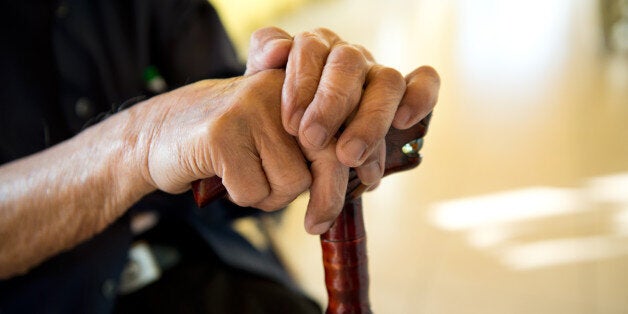
Just days before Southbank Centre's Unlimited Festival, celebrating extraordinary work by disabled artists, is Collective Encounter's 'Rediscover the Radical' conference at LIPA, Liverpool. So why are disabled artists seen as radical?
Disabled artists aren't new, we've always been here. First they tried to shut many of us away. Others, who could, hid in plain sight - reducing who they were, pretending, minimizing themselves. But there have always been disabled artists.
Some of us found our way into the freak shows - parading our difference, pay per view. Exploitation or entrepreneurship seems to have depended on the company you keep - then same as now. But there were always disabled artists.
In asylums, others took the credit for our work, not naming us but instead glorifying the shrinks, the therapists, the doctors who happened to be assigned to us. But there were always disabled artists.
In Germany, we were the first to go, even though we are still the least remembered. Useless eaters, we were called. Wartime, Hitler suggested, "was the best time for the elimination of the incurably ill." But even then - even there - there were disabled artists.
There have always been disabled artists, because there have always been disabled people. Some disabled people will always be artists, because artists are human and because we - disabled people - are human. It's simple really.
Yet disabled artists are consistently seen as different, odd, edgy, subversive, 'not mainstream', 'NQR' meaning 'not quite right' in medical slang, often written on the notes of disabled people, particularly at birth. We've always not quite fitted in. We've always had to fight for our right to be here - and therefore to make, and see and be part of the arts.
Many of us don't want to have our impairments shifted or changed, but we would like to be perceived as 'normal' - accepted as part of the 'normal' diversity of humanity. To have provided the things that we need in order to take part and function fully as artists, participants or audience members.
However, the arts world isn't designed to meet our needs. It could be - it could be adapted and made accessible - but this doesn't happen often. When it does, it takes huge effort, usually on our part, and often involves us being seen as 'a problem' that needs to be solved.
It doesn't see us as we do - as having a unique perspective, an important voice, new innovative techniques, a way of being in the world that can add to the aesthetic of the arts in various ways.
Instead, it consistently pours out stereotypes that see us as broken, a hindrance, a burden, as ugly, as flawed, as abnormal. Often the stories that are most commercially successful call for us to die.
And that's if we feature at all. The arts world most often ignores us, pretending we don't exist even though we make up a fifth of the population. We are invisible. We are not represented.
Is it through fear? Prejudice? Oppression? Or simply the result of ignorance, lack of fore thought, unwitting discrimination? Does it matter? The result is the same.
There have always been disabled artists. Not that they got the profile, the credit, the attention or the resources. I say 'got' rather than 'get' as there has been shift. More resources, more focus, more attention. More often to tick a box than in true recognition of our talent, skills and potential, but shift none the less.
Disability - still seen as a radical act in the arts sector. Disabled artists - still seen as radical, no matter what they make. Sometime the work is radical. For many artists, the above can't help but seep into the work. And often the work is better for that.
I'm the senior producer for Unlimited, a commissions programme that focuses on art led by disabled artists delivered by Shape and Artsadmin. Most of our work is featuring at Southbank Centre's Unlimited Festival next week in London, and Tramway's Unlimited Festival in Glasgow (15-25th Sept). So do all our artists make radical work? Perhaps - it depends on what you define as radical.
Liz Carr's Assisted Suicide: The Musical, one of our commissions. It fuses personal passion politics with song and dance. Radical in subject matter, radical in form and possibly one of the only musicals to date to feature an access hoist and glitter.
Naomi Lakmier's Cherophobia is a different kind of radical. A 48 hour durational piece where she is tied and bound and then has helium balloons attached to her prone body. 20,000 of them. Her piece looks at just what it takes to lift her off the ground. Again, radical in form, and in meaning for those of us who get just what lies beneath her intention.
Aaron Williamson's Demonstrating the World - ripping the piss out of YouTube videos that tell us how to do everything in minute detail. Again, implying that we are all the same and do things in exactly the same way.
Claire Cunningham and Jess Curtis in The Way You Look (At Me) Tonight - looking at perception and how we see each other. Is that radical? Is this work radical? To many, a dancer using crutches still challenges notions of who can dance, is a radical intervention, subverting the art form.
Jess Thom and Ted Shiress do stand up - or as Jess's piece is called: Stand Up, Sit Down, Roll Over. Jess has Tourettes syndrome and says the word 'biscuit' 16,000 times a day, along with a whole host of others - is it radical if you can't control every word that comes out of your mouth? Perhaps it's a radical reinterpretation of stand up when disabled artists turn the tables and laugh at you?
Sheila Hill directs Him, with deaf actor Tim Barlow. Gently radical in that the actor in the spotlight is in his 80's and has been deaf for most of his life. Radical for showing that we age?
Nye Russell-Thompson stammers. His company is called Stammermouth so he doesn't hide the fact. His solo piece is called 'In Just A Few Words' - easier for me to say than him. Radical for exposing a voice that in the way we choose to hold our society at the moment usually gets silenced.
We don't commission 'radical work' on purpose - we commission art by disabled artists, so often it's a by-product.
Does all this work, all this funding, all this attention mean that things are getting better? More equal? Less discrimination? No. Have no doubt. Disabled people are under attack right here in the UK, on a daily basis. It's been shown that disabled people have been hit harder by austerity measures than anyone else. 19% harder financially. We've lost a key benefit - Disabled Living Allowance - replaced by PIP that really doesn't replace much at all. We've had the support that helped us work - Access to Work, reduced and capped and repeatedly blocking, for example, support for international work disabled people might get.
As much as we try to promote a sense of disability = equality, the signs are still all around us reinforcing the perspective that actually we are second class. The Paralympics in Rio for example, where the budget for the Paralympics was raided so that the 'normals' could have their games?
Disabled people: radical because the world still isn't designed to let us in. Disabled artists: radical because who we are and what we experience every day, comes out in our art and how others perceive the work that we make.
There are many disabled artists. We are here. If you work in the arts, it's not our job to get us included in what you do, it's yours.
